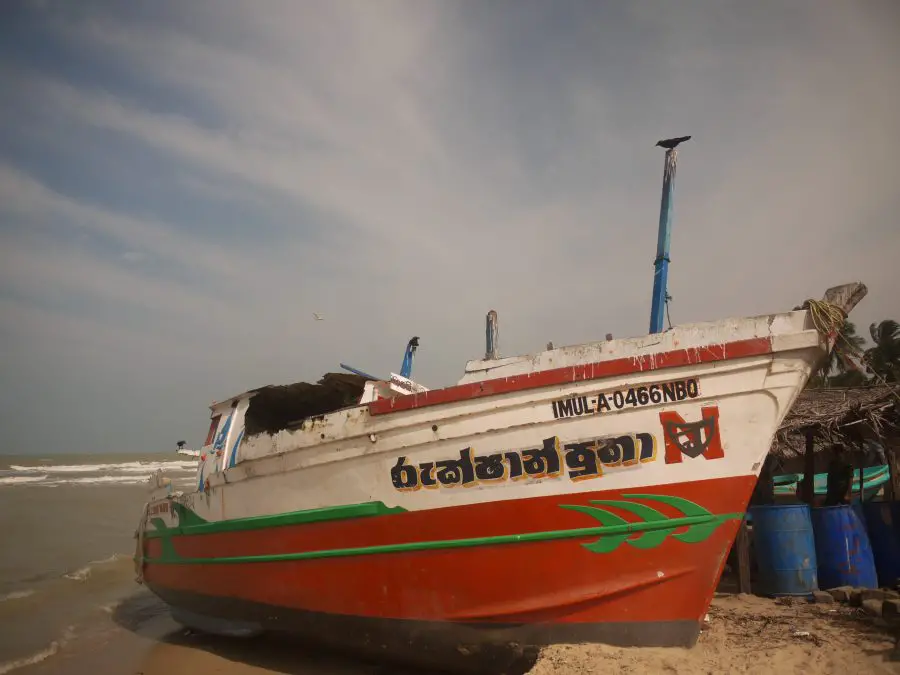Despite being advised not to take the coast road from Jaffna to Mannar, we did and as soon as we left Jaffna behind we regretted our decision. Little more than a two lane dirt-track, there was no road surface of any kind and the red dust billowed in the windows non-stop for the slow six hour journey. Hitting bumps that often had us and the other passengers two feet high off our seats we just held on laughing for most of the journey, there was no turning back and not much else we could do. Being the only foreigners on the bus, all eyes were on us to see how we were coping with the rocky ride and every where we looked smiles were flashed back at us by young and old. Along the barren road we passed a few small communities but for the most part it was military bases which lined the way and from the bus we could see soldiers taking part in marching drills and other training. Stopping the bus at various checkpoints, they got on-board once to do a bag spot check but left us be, it seems that even though the war is over the government keeps a strong presence in this area regardless.
A thick film of dust covered our bags by the time we pulled them out of the storage area in the back of the bus and we were worn out after the helter skelter spin to get here but we had made it. We immediately started walking in the direction of our guest-house, delighted with the opportunity to stretch our legs. Similar to our experience in Jaffna, we immediately felt a relaxed, genuine, local vibe here and nothing was ‘put on’ for tourists. Flying by on motorbikes and in the back of vans everyone waved at us as we lugged our packs up the road. Unusually, we saw a lot of donkeys, not native to Sri Lanka, around the roads and in the bus station and later learned that they had been brought by Arab traders many years ago.

Donkeys stroll around this town like they own the place, originally brought to Mannar by Arab Traders.
The peninsula which juts out into the Palk Strait is primarily Muslim with some Hindus and Christians living here also. At the tip of the peninsula is where India and Sri Lanka are closest, separated by ony thirty kilometres of water. Having already visited the same point in India at Rameswarem, reaching the small fishing village of Talaimannar at the peninsulas edge, where ferry services used to run between the two countries up until 1964 but since suspended, was our principal reason for coming here.
Talaimannar was an hour bus journey from Mannar town passing through quite a desert like landscape along the way with only a few trees to break up the views as well as a few small communities living in traditional style homes with palm tree roofs and mud-clay walls. Hit hard by the war in Sri Lanka, evidence of the damage was everywhere as we got closer to Talaimannar. As soon as the bus stopped a short walk took us to the end of the peninsula and we were blown away. A strip of white sand separates the land from the turqoise blue waters, colourful boats glisten in the strong sun and weather beaten fishermen work hard gathering fish from their nets, gutting some of their catch or repairing their nets in teams. Everyone was excited to see us coming along the beach and even some of the older fishermen beckoned us over to take their picture, laughing when they saw
themselves on the screen. An abandoned lighthouse at one end of the beach used to guide boats passing through the Palk Strait but today it just stands there overlooking the fishermen going about their day. There is a heavy navy presence here, with gunboats moored just offshore and a soldier standing guard at the edge of the rusting pier which before the war served passenger ferries and cargo ships between neighbouring India and Sri Lanka. Now ruined and in complete disrepair the pier and the nearby abandoned railway station serve as a stark reminder to the devastation this area went through but with that said, it’s the people of Mannar and Talaimanar that make a visit to this very much unvisited place more than worthwhile as they bring a refreshing sense of reality to a country where in other parts is becoming over run by the greed which the tourism trade can bring.

Brian is a travel writer, photographer, blogger, travel addict and adventure-junkie. Being outdoors, getting off the beaten track and outside his comfort zone is what makes him tick. Brian’s the dreamer in the relationship; when he’s not travelling, he’s dreaming about it! Keeping fit, cooking, music and red wine take up the rest of his time.
Sign up for our free travel photography Ebook "Faces of Nepal" and you'll also receive our monthly newsletter.







